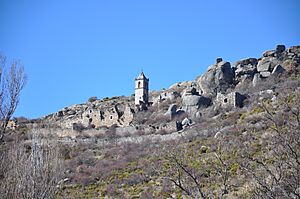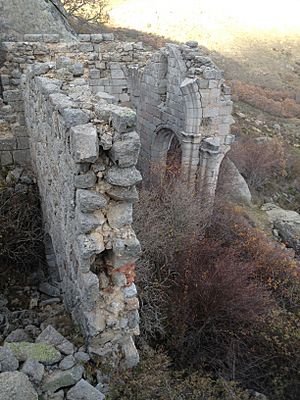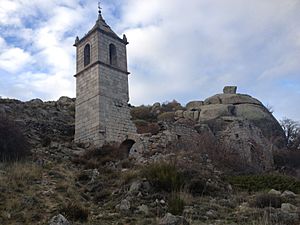Monastery of Our Lady of the Risco facts for kids
Quick facts for kids Monastery of Our Lady of the Risco |
|
|---|---|
 |
|
| Religion | |
| Affiliation | Roman Catholic church |
| Province | Diocese of Ávila |
| Ecclesiastical or organizational status | Ruined |
| Year consecrated | 1504 |
| Location | |
| Location | Amavida, Ávila, Castile and León , Spain |
| Architecture | |
| Architectural type | Late gothic |
| Completed | ? |
The Monastery of Our Lady of the Risco is an old Augustinian convent that is now in ruins. It is located high up above the town of Amavida in the Sierra de Ávila mountains, in Castile and León, Spain.
A man named Francisco de la Parra started the monastery in 1504. It was dedicated to Our Lady of Sorrows, also known as Our Lady of the Risco. This monastery was very important for spreading Christian teachings. It was also one of the only cultural centers in the area during the Late Middle Ages.
The monastery used to have many buildings. These included a church, a cloister (a covered walkway), and homes for the monks. It also had an oriel (a type of window), farming terraces, and a place for pilgrims to stay. There were stables for animals and storage rooms. It even had a good system for water and roads to get there. Today, only the bell tower remains. You can also see the entrance arch of the old church. Part of the apse (the rounded end of the church) is still there, but plants hide it. Some parts of the old walls also remain.
Contents
Where is the Monastery Located?
The monastery is in the Valley of Amblés. It is to the northwest of the town of Amavida. You can easily see it from the town.
From the top of the old tower, you can see the whole valley. Mountains surround the valley. To the south is the Sierra de la Paramera. To the west is La Serrota. To the north is the Sierra de Ávila. On very clear days, you can even see Navacerrada in the Community of Madrid. You might also spot the mountain of the Dead Woman, which is in Segovia.
The monastery used to be a meeting point for three old paths. These paths came from Villatoro, Vadillo de la Sierra, and Amavida. Today, you can reach the monastery from Amavida. You follow old stone roads that are partly paved. You can also get there from the north, using the path from Vadillo de la Sierra.
A Look at the Monastery's History
Ancient Markings
The oldest things found where the monastery stands are some rock carvings. These are called petroglyphs. You can see them near the ruins. In a hollow between large rocks, there are two circles carved into the stone. One circle is twice as big as the other. A triangle separates them.
Some people think the triangle might show a mountain. The circles could be the sun and the moon. This idea fits because they face a peak called Risco del Sol. This peak is on the other side of the Valley of Amblés. But we don't know for sure what these carvings mean or who made them.
The Legend of the Virgin
According to an old story, people started worshipping here a long time ago. This was during the time of the Muslim conquest of Spain. Christians hid an image of the Virgin of Sorrows in this area. They wanted to protect it from being destroyed.
The story says that in the 14th century, around 1320, a shepherd found the image. He was looking for a lost goat. He found the image of the Virgin of the Risco in a cave. It was a statue of the Virgin Mary leaning on a cross. She was holding her dead son in her arms.
From Chapel to Convent
In 1504, Fray Francisco de la Parra built a small chapel. He built it among the stones where the image was found. He named it Nuestra Señora del Risco. Father Francisco was an Augustinian monk. He had led important monasteries in Castile. He wanted to retire to this quiet place. But he was very active. So, after a few years, he asked for permission. He got approval to create a convent there.
So, in 1530, the chapel became a convent for the Augustinian order. It was built in a style called Late Gothic. It also had some features that looked like the Herrerian style.
Growth and Wealth
In 1564, the convent got permission to ask for donations. This helped it become very wealthy. It was not just a place for prayer. It became a rich and important center in the region.
During the 17th century, the monastery owned a lot of cattle. They had up to 5,000 sheep! But they also made money from farming and other businesses. The church was updated in the late 1600s. In 1775, its beautiful tower was built. New altars were added to the church in 1791.
Decline and Abandonment
The monastery started to decline in the 1800s. During the War of Independence, it became a hiding place for fighters. It was damaged by the French army. Locals also looted it. They took things from the monastery because they had suffered for years.
After that, only a few monks stayed. In 1835, a new law said convents with fewer than twelve monks had to close. The Monastery of Our Lady of the Risco was affected by this law. It was then abandoned and fell into ruin.
What Happened to Its Treasures?
Most of the monastery's clothes, jewelry, and bells were moved. The image of the Virgin Mary was also taken. They went to the parish church in Villatoro. Today, the image of Our Lady of Sorrows is on the main altar there.
Other items from the monastery went to different places. Some went to Piedrahíta. The best set of religious garments went to a convent in Ávila. The statue of Saint Augustine went to the church in Vadillo de la Sierra.
Two prayer books were sent to a sanctuary in Ávila. Some images from the Risco even ended up in the Ávila Cathedral.
The Monastery and the Mesta
The monastery's cattle were part of the transhumance. This means they moved between pastures in Castile and Extremadura. But most of the time, the monastery's cattle moved shorter distances. They went to places like Campo Arañuelo and Fuente el Caño meadow in Gálvez.
The monks of the Risco were part of an organization called the Mesta. This group helped manage sheep herding. The monks used the Mesta to protect their interests. They also paid money to support it. The Risco monastery even made extra payments to the Mesta. This was a way of thanking the Mesta for helping the king when he needed money.
Important People Connected to the Monastery
The monastery was a significant place for the Augustinians order. Many important people spent time there. These include:
- Payo Enríquez de Rivera: He was a Viceroy of New Spain.
- Enrique Flórez de Setien: A famous Augustinian historian.
- Manuel Risco: Another Augustinian historian. He helped write a very important history book called España Sagrada.
Other Interesting Places Nearby
Around the monastery, there are many other historical sites. These make the area very interesting to visit:
- Verraco de Villanueva del Campillo: This is the largest ancient stone animal sculpture in the Iberian Peninsula.
- Cañada Real Leonesa Occidental: An old drovers' road for moving livestock.
- Castro de Ulaca: An ancient fortified settlement in Solosancho.
- Necropolis of La Coba: An ancient burial ground.
- Sanctuary of Our Lady of the Fuentes: A religious sanctuary.
- Bridge of the Cobos: An old bridge.
- Castro of the Castillejos (Sanchorreja): Another ancient fortified settlement.
- Castro de la Mesa de Miranda: An ancient hillfort.
- Castle of Aunqueospese: An old castle.
- Castle of Villaviciosa: Another historic castle.
- Work by the Basque sculptor Agustín Ibarrola: Art installations in the Dehesa de Garoza in Muñogalindo.
See also
 In Spanish: Monasterio de Nuestra Señora del Risco para niños
In Spanish: Monasterio de Nuestra Señora del Risco para niños





